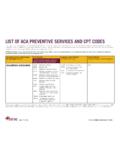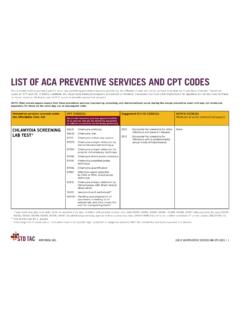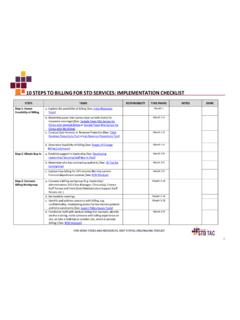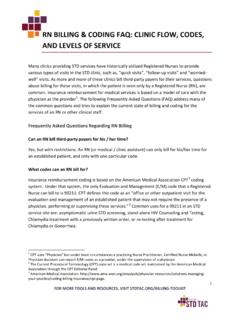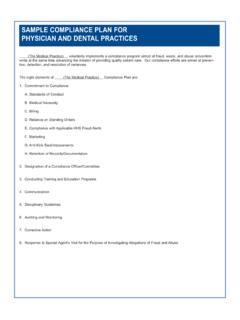Transcription of TEN STEPS TO CONTRACTING WITH INSURANCE …
1 STEPS TO CONTRACTING with INSURANCE COMPANIES | 1 TEN STEPS TO CONTRACTING with INSURANCE COMPANIES1. Determine the third-party payers with which you want to contract Assess the coverage mix of your patient population to determine which third-parties are used most often by your patients; you can do this via a patient survey. For most clinics, 50 inquiries or four weeks of data collection should provide enough informa-tion to determine the prevalent INSURANCE compa-nies in your patient population. (See: Sample Payer Mix Survey: For Clinics Not Billing and Sample Payer Mix Survey: For Clinics with Limited Billing)2.
2 Collect information about CONTRACTING with particular INSURANCE companies Call colleagues and ask if they have contracts with the INSURANCE companies with which you are interested in establishing contracts. Ask them for a contact name, staff person s title, direct phone number or email address. Ask them about their experiences with the process and how long it took to obtain a contract. If you are unable to locate a colleague with a similar practice, ask your Medical Director if s/he belongs to the IPA (Independent Practice Association) at the hospital where s/he has privileges. If s/he has a con-tact at the IPA, the IPA as a courtesy to your physi-cian may be willing to help you navigate obtaining a contract with a particular INSURANCE company.
3 Call the INSURANCE company s Provider Line and ask how to become a provider. When contacting INSURANCE companies, ask if your practice would be considered a medical practice or an ancillary practice. 1 INSURANCE companies often have different people handling these two types of applications . This will help you get connected to the right purpose of this tool is to provide step -by- step guidance and tips for successfully CONTRACTING with INSURANCE Initiate contact with INSURANCE company Ask for the name and phone number of a contract person. Ask them to send you an application or if possible, how to download an application.
4 INSURANCE companies often ask that your clinic sends a letter requesting to become a provider. Hint: You may need to go through this process several times before you receive an application. 4. Obtain NPI (National Provider Identifier) numbers for the practice and clinicians NPI (National Provider Identifier) is a unique 10-digit identification number issued to health care provid-ers in the United States by the Centers for Medicare and Medicaid services (CMS).2 [See: Obtaining a National Provider Identification Number]5. Credential your clinicians Have your clinicians register with the Council for Affordable Quality Healthcare s (CAQH) Universal Provider Datasource (UPD).
5 UPD enables healthcare providers to submit, store, update and access their information for credentialing. This standard form meets the data-collection needs of health plans, hospitals and other healthcare organizations. 3 [See: Provider Credentialing: Overview and Checklist] Collect and keep on file copies of all clinical licenses, copies of Medical Degrees, DEA information, mal-practice information, overhead INSURANCE coverage, board member s information, hours of operations, NPIs, Tax ID Number, and SSN of managing officer. Have all these copies available to you when you need to complete the application (next step ).
6 STEPS TO CONTRACTING with INSURANCE COMPANIES | 26. Complete the application Make copies of the application and all attachments for your records and in case the application is lost. Follow up regularly with each application. Questions to ask your contact at the INSURANCE company credentialing department include: The status of the application. How often the board meets to approve new applications . How long it will take after the application is approved to receive the fee schedule and contract. How long before you can start charging the INSURANCE company for their covered patients. Depending on the INSURANCE company this process can take up to six months.
7 The key to obtaining an INSURANCE contract is constant follow-up. 7. Review the terms and rates of the contract Know the cost of your services. [See: It Pays to Know Your Cost: Cost Analysis Webinar Series and Tools] Consider if the third-party contract will generate non-covered services. If so, factor that into your financial analysis. Verify all contract terms and ensure that your clinic or lab and finance department can meet the contract terms. Above and beyond the fee sched-ule, consider infection control, licensing, quality assurance, site visit, and any other requirements that are stated within the contract.
8 Violating the stated requirements can be grounds for lost reim-bursement or contract Negotiate any objectionable conditions Check the contract for paragraphs that can restrict your ability to collect reimbursement. It is not uncommon for third-party payer contracts to include language that requires billing for reimbursement within 60 days post service and/or to have restric-tions for corrected claims reimbursement. Note: it is possible to modify these terms, as well as other contract terms. Read the entire agreement from the third-party payer and ensure that it includes a description of covered services as well as a current fee schedule.
9 Ideally, the fee schedule should include the proce-dure codes for all of the services you provide, but it must include the procedure codes and expected reimbursement for all of the covered services. If a fee schedule is not included within the contract or was not otherwise shared with you, request a fee sched-ule from the payer before you sign the contract. [See: Fee Assessment and Collection] It is risky and not recommended that one sign a contract that does not include a fee schedule. [See: Model Contract]9. Sign contract Discover the person in your organization who is authorized to establish contracts and keep them informed about your efforts to initiate contracts with INSURANCE providers.
10 10. Keep contract on file for renewal and annual updating of fees You will need to periodically access your contract for periodic renewal or the annual updating of fees. Keep your contract on file and readily TAC 2014. Thank you to Roberta Moss, Moss Healthcare Consulting, for her contributions to this Examples of ancillary providers include: Family Planning, Nutrition, Ambulance, and Physical National Plan & Provider Enumeration System (NPPES). Council for Affordable Quality Healthcare (CAQH).
